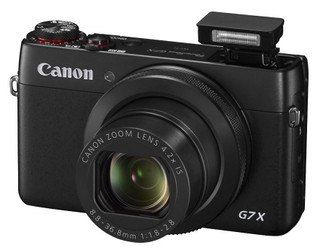Canon G7X Wet Lens Tests
June 18th, 2015
Canon G7X Wet Wide Angle Lens Tests
For full information on the camera, read our full Canon G7x review.
The Canon G7X is an incredible compact camera. Finally responding to Sony's success with the large 1" sensor of the RX100 series, Canon released the G7X that matches the 1" sensor size and offers all the other great features of other Canon compacts, such as the built in macro focus and easy to accomplish custom white balance.
However, with a 24-70mm equivalent lens, this camera runs into a few problems when trying to use a wet wide angle lens. Most of these lenses are designed around a 28mm lens, and when used with a wider camera vignetting can occur. We took to the pool to find out which lenses offer the best overall image quality when paired with the G7X and different housing options. Read on to see the results!
Fantasea Results | Nauticam Results | Recsea Results
For these wet wide angle tests we stood on the same line in a shallow pool and centered the 3ft tile in each picture to maintain a good reference for the angle of view for easy comparison in each shot.
Overall Recommendation:
Best Results:
- Nauticam Housing + N50 Short Port + Dyron Super Wide
- Nauticam Housing + N50 Short Port + Nauticam WWL-1 Lens
Most Flexibility:
- Nauticam Housing + Nauticam WWL-1 Lens (Standard Port)
Best Value:
Our tests determined that if you are looking for the ultimate wide angle option with the Canon G7X we recommend the Nauticam G7X Housing paired with the N50 Short Port and Dyron Super Wide Angle Lens. This set up with give you the widest field of view and best image quality. If your goal is a flexible camera system allowing you to use both wide and macro on the same dive we recommend either the Recsea or Nauticam housings (using the standard port with the Nauticam). The Fantasa housing is also a good option, though the Bigeye dome does not provide as wide a field of view as you can get with the Recsea or Nauticam. If you are on a budget though, the Fantasea housing and Bigeye dome combination is very good.
Fantasea Housing:
The best option for the Fantasea G7X underwater housing is the Fantasea Bigeye Lens. While this lens doesn't actually provide a wider field of view, what it does do is reverses the magnifying effects of refraction underwater. You'll get the "in air field of view" with the BigEye lens attached, which is about 25% wider than without it, offering a nice increase in field of view. Other lenses vignette too much with the G7X to be of value with this housing due to having to use an adapter on the port.










Nauticam Housing:
The Nauticam housing is unique in that it features a removeable front port. We ran these tests with the standard port to find out what results would look like for those who did not want to purchase two port options, or for those looking for the most flexibility in their G7X system. With the standard port you maintain the ability to zoom all the way in and out which makes it useful for being able to switch between macro and wide angle lenses on the same dive. Unfortunately though your wide angle quality will suffer. All available lenses will offer vignetting, though you can zoom through on both the Inon and the Dyron Super Wide Angle Lenses and still have a nice wider field of view. For the widest results we recommend the Dyron Super Wide Angle Lens.
For the BEST wide angle you can get you'll want to purchase the Nauticam N50 Short Port. This does not allow for any zoom so you will need to lock down the zoom lever on the camera to avoid accidental zooming. Paired with the Dyron Super Wide Angle lens you'll get a crisp and extremely wide image for excellent reef scenes, wrecks, big animals etc!
Here are the results of our tests with the Standard Port:









Recsea Housings
Recsea now offers two versions of housings, the original, high quality, aluminum housing which features full camera controls and a deeper depth rating and a new option for those on a budget, the "CW" polycarbonate housing. This option does not offer a rear control wheel but does have a clear back panel so you can easily check o-ring seal. Both of these housings also offers built in 67mm threads, a new feature for Recsea. This does mean that there will not be support for the popular quick release kits, but the threaded lenses are much more secure. Results were found to be the same between both housing options and very similar to the Nauticam with vignetting across the board and the Dyron Super Wide coming in as the winner. Here are the photos:












